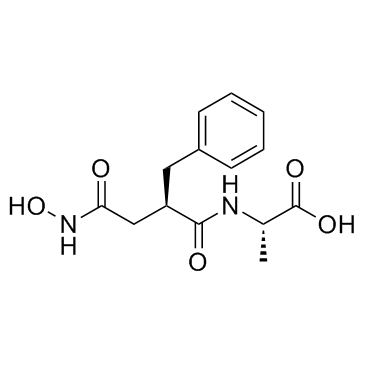Kelatorphan
Modify Date: 2024-01-09 10:32:38

Kelatorphan structure
|
Common Name | Kelatorphan | ||
|---|---|---|---|---|
| CAS Number | 92175-57-0 | Molecular Weight | 294.30300 | |
| Density | 1.301g/cm3 | Boiling Point | N/A | |
| Molecular Formula | C14H18N2O5 | Melting Point | N/A | |
| MSDS | N/A | Flash Point | N/A | |
Use of KelatorphanKelatorphan is a full inhibitor of enkephalin degrading enzymes. |
| Name | (2S)-2-[[(2R)-2-benzyl-4-(hydroxyamino)-4-oxobutanoyl]amino]propanoic acid |
|---|---|
| Synonym | More Synonyms |
| Description | Kelatorphan is a full inhibitor of enkephalin degrading enzymes. |
|---|---|
| Related Catalog | |
| Target |
Enkephalin degrading enzyme[1]. |
| In Vivo | The administration of Kelatorphan alone (50 μg) could result in a strong increase of intact [3H]enkephalin content corresponding to 80±11% of total recovered radioactivity[2]. In normal awake rats, Kelatorphan (10±20 mg/kg i.v.) increases minute-volume. The increase in ventilation is due to a dose-dependent increase in breathing frequency. In arthritic rats Kelatorphan (20 mg/kg i.v.) increases ventilation and there is no significant difference between arthritic and non-arthritic rats. In pentobarbital-anesthetized rats, a slight (116%) but significant increase of respiration is also produced by Kelatorphan (20 mg/kg, n=6) 10±15 min after administration. The effects of Kelatorphan are not antagonized by a pretreatment with a small dose of naloxone (0.2 mg/kg i.v., 15 min before Kelatorphan), but a larger dose (1 mg/kg) significantly antagonized Kelatorphan (20 mg/kg) at 5 and 10 min in awake rats[3]. |
| References |
| Density | 1.301g/cm3 |
|---|---|
| Molecular Formula | C14H18N2O5 |
| Molecular Weight | 294.30300 |
| Exact Mass | 294.12200 |
| PSA | 115.73000 |
| LogP | 1.11190 |
| Index of Refraction | 1.567 |
| Hazard Codes | Xi |
|---|
| kelatorphan |
| L-Alanine,N-(4-(hydroxyamino)-1,4-dioxo-2-(phenylmethyl)butyl)-,(R) |
| (3-(N-Hydroxy)carboxamido-2-benzylpropanoyl)alanine |
| n-[(2r)-2-benzyl-4-(hydroxyamino)-4-oxobutanoyl]-l-alanine |